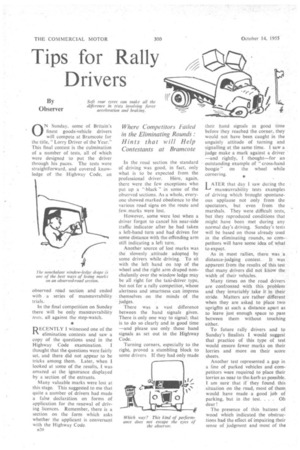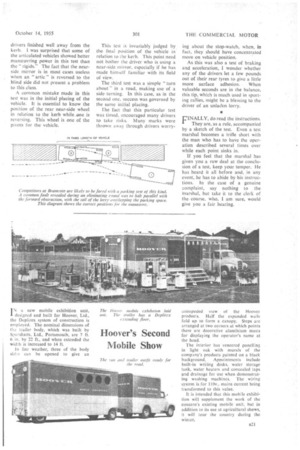Tips for Rally Drivers
Page 54

Page 55

If you've noticed an error in this article please click here to report it so we can fix it.
By Observer
ON Sunday, some of Britain's finest goods-vehicle drivers will compete at Bramcote for the title, "Lorry Driver of the Year." This final contest is the culmination of a number of tests, all of which were designed to put the driver through his paces. The tests were straightforward, and covered knowledge of the Highway Code, an
observed road section and ended with a series of manceuvrability trials.
In the final competition on Sunday there will be only manceuvrability
• tests, all against the stop-watch.
RECENTLY I witnessed one of the
elimination contests and saw a copy of the questions used in the Highway Code examination. I thought that the questions were fairly set, and there did not appear to be tricks among them. Later, when I looked at some of the results, I was amazed at the ignorance displayed by a section of the entrants.
Many valuable marks were lost at this stage. This suggested to me that quite a number of drivers had made a false declaration on forms of application for the renewal of driving licences. Remember, there is a section on the form which asks whether the applicant is conversant with the Highway Code, R20 In the road section the standard of driving was good, in fact, only what is to be expected from the professional driver. Here, again, there were the few exceptions who put up a "-black" in some of the observed sections. As a whole, everyone showed.marked obedience to the various road signs on the route and few. marks were lost.
However, some were lost when a driver forgot to cancel his near-side traffic indicator after he had taken a left-hand turn and had driven for some distance with the offending arm still indicating a left turn.
Another source of lost marks was the slovenly .attitude adopted by some drivers while driving. To sit with the left hand on top of the wheel and the right arm draped nonchalantly over the window ledge may be all right for the taxi-driver type, but not for a rally competitor, whose alertness and smartness can impress themselves on the minds of the judges.
There was a vast difference between the hand signals given. There is only one way to signal; that is to do so clearly and in good time —and please use only .those hand signals as set out in the Highway Code.
Turning corners, especially to the right-, proved a stumbling block to some drivers. If they had only made their hand signals in good time before they reached the corner, they would not have been caught in the ungainly attitude of turning and signalling at the same time. I saw a judge make a mark against a driver —and rightly, I thought—for an outstanding example of "cross-hand boogie" on the wheel while cornering.
LATER that day I saw during the manceuvrability tests examples of driving which brought spontaneous applause not only from the spectators, but even from the marshals. They were difficult tests, but they reproduced conditions that might have been met during any normal day's driving. Sunday's tests will be based on those already used in the eliminating rounds, so competitors will have some idea of what to expect.
As in most rallies, there was, a. distance-judging contest. It was apparent from the results of this test that many drivers did not know the' width of their vehicles.
• Many times on the road drivers are confronted with this problem and they invariably take it in their stride. Matters are rather different when they. are asked to place two upriglits at such a distance apart as to leave just enough space to pass between them without touching either.
To future rally drivers and to Sunday's finalists I would suggest that practice of this type of test would ensure fewer marks on their lorries and more on their score sheets.
Another test represented a gap in a line of parked vehicles and competitors were required to place their lorries as near to the. kerb as possible. I am sure that if they found this .situation on the road, most of them would have made . a good job of parking, but in the test. . .
dear !
• The presence of thin battens of wood which indicated the obstructions had the effect of impairing their sense of judgment and most of the
drivers finished well away from the kerb. I was surprised that some of the articulated vehicles showed better manoeuvring power in this test than the " rigids." The fact that the nearside mirror is in most cases useless when an " artic " is reversed, to the blind side did not present a problem to this class.
A common mistake made in this test was in the initial placing of the vehicle. It is essential to know the position of the rear near-side wheel in relation to the kerb while _one is reversing. This wheel is one of the pivots for the vehicle. This test is invariably judged by the final position of the vehicle in relation to the kerb. This point need not bother the driver who is using a near-side mirror, especially if he has made himself familiar with its held of view.
The third test was a simple " turn about" in a road, making use of a side, turning. In this case, as in the second one, success was governed by the same initial placing.
The fact that this particular test was timed, encouraged many drivers to take risks. Many marks were thrown away through drivers worry
jog about the stop-watch, when, in fact, they should have concentrated more on vehicle position.
As this was also a test of braking and acceleration, I wonder whether any of the drivers let a few pounds out of their rear tyres to give a little more surface adhesion. When valuable seconds are in the balance, this tip, which is much used in sporting rallies, might be a blessing to the driver of an unladen lorry.
FINALLY, do read the instructions. They are, as a rule, accompanied by a sketch of the test. Even a test marshal becomes a trifle short with the man who has to have the operation described several times over while each point sinks in.
If you feel that the marshal has given you a raw deal at the conclusion of a test, keep your temper. He has heard it all before and, in any event, he has to abide by his instructions. In the case of a genuine complaint, say nothing to the Marshal, but take it to the clerk of the course, who, I am sure, would give you a fair hearing.




















































































































